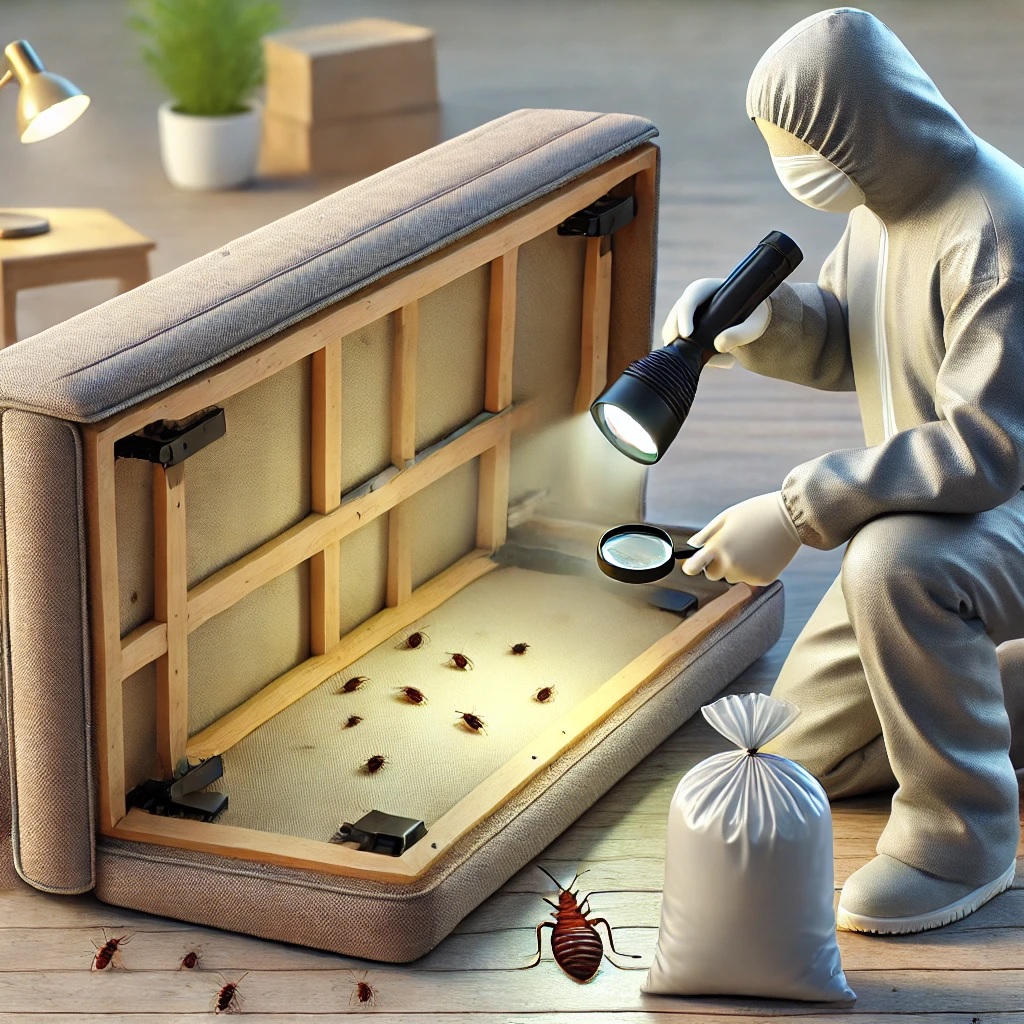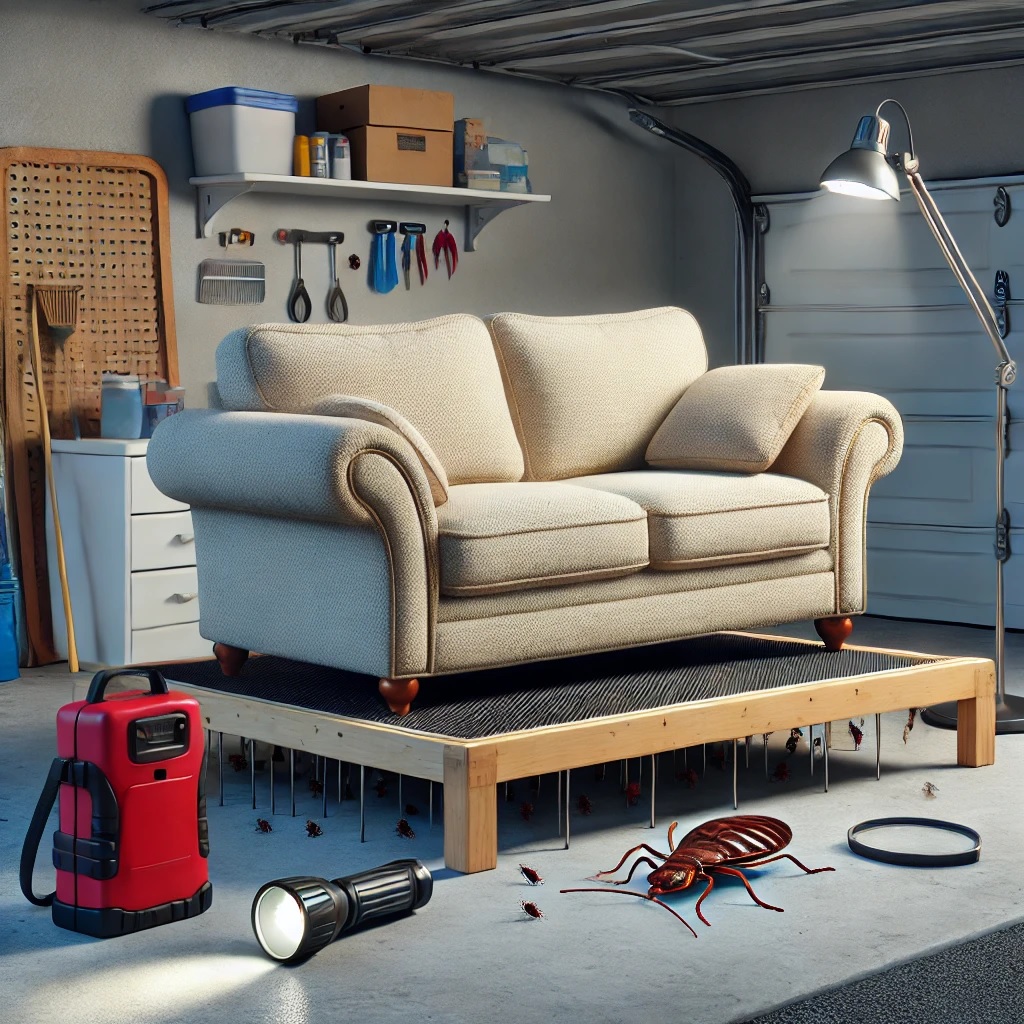There’s nothing like finding a hidden gem at a second-hand shop or snapping up a stylish vintage piece at a bargain price. But with these treasures comes a hidden risk: bed bugs. These tiny pests can easily hide in furniture, and once they’re in your home, they’re incredibly difficult to get rid of.
At Thermopest, we’ve seen far too many cases where a lovely piece of furniture became the gateway to a bed bug infestation. But don’t worry—you can avoid this with a careful inspection before bringing anything second-hand into your home. Here’s your step-by-step guide to checking second-hand furniture for bed bugs.

Why Bed Bugs Love Second-Hand Furniture
Bed bugs aren’t picky. They’ll happily make themselves at home in just about any piece of furniture, as long as they have somewhere to hide. Sofas, mattresses, wooden furniture with cracks, or anything with upholstery are perfect hiding spots for these pests. They’re small, sneaky, and incredibly hard to spot if you don’t know what you’re looking for.
In second-hand furniture, bed bugs can hide in seams, cracks, and joints, making it easy for them to travel from one home to the next. That’s why it’s so important to inspect anything thoroughly before bringing it into your space.
Tools You’ll Need for a Bed Bug Inspection
Before diving into your inspection, it’s a good idea to gather a few simple tools. You don’t need much, but these items can make spotting bed bugs easier.
- A flashlight: Bed bugs love dark, tight spots, so a good light helps you see into every corner.
- Magnifying glass: Bed bugs are tiny, and their eggs are even smaller. A magnifying glass will help you see what’s hiding in those crevices.
- Gloves: You’ll want to protect your hands during the inspection.
- Sticky tape or a bed bug trap: Handy for catching any bugs you might disturb during your inspection.
- Screwdriver or flat tool: This will help you get into the joints and seams of furniture where bed bugs like to hide.
Step-by-Step Guide to Inspecting Second-Hand Furniture for Bed Bugs
Now that you’re armed with the right tools, let’s get down to the inspection process. Follow these steps to ensure you’re not bringing any uninvited guests into your home.
1. Start with a Visual Inspection
Before you get into the nooks and crannies, take a general look at the furniture. Look at the seams of upholstery, around buttons or tufts, and in any cracks or joints. Bed bugs are small, but they often leave behind tell-tale signs like tiny black dots (their faeces) or pale yellow skins that they shed as they grow.
2. Check for Physical Signs of Bed Bugs
What are you looking for? Bed bugs are small, reddish-brown, and about the size of an apple seed. If you see them, it’s pretty clear what you’re dealing with. But even if you don’t spot the bugs themselves, keep an eye out for:
- Black spots: Bed bug faeces, which look like little ink stains.
- Shed skins: Bed bugs shed their skins as they grow, so look for pale yellow or translucent shells.
- Tiny white eggs: These are harder to spot, but bed bug eggs are about the size of a pinhead and are often stuck to fabric or wood.
3. Focus on Cracks and Joints
Bed bugs love tight spaces. If you’re inspecting wooden furniture, be sure to check in the joints, underneath drawers, and in any cracks. Use your flashlight and magnifying glass to look closely. Bed bugs can squeeze into tiny spaces, so leave no stone unturned.
4. Don’t Forget Hidden Areas
If the furniture has cushions, zippers, or removable covers, be sure to check underneath and inside. Bed bugs like to hide in fabric folds, under cushions, and between cracks. With wooden furniture, check the undersides and backs of drawers as well.
5. Look for Eggs
Bed bug eggs are small, sticky, and usually white or cream-coloured. They can be found in tight spaces like mattress seams, wood joints, or underneath fabric. These are harder to spot but are a clear sign that the furniture could be harbouring bed bugs.
6. Use a Bed Bug Trap or Sticky Tape
If you suspect bed bugs but haven’t seen any clear signs yet, use a trap or sticky tape to pick up anything that might be crawling around. You can place traps under the legs of the furniture or use tape to lift any bugs or eggs you find during your inspection.
What to Do If You Find Signs of Bed Bugs
So, you’ve done a thorough check and—unfortunately—found signs of bed bugs. What’s next?
- Isolate the Furniture
First things first: don’t bring it inside! If the furniture is already in your home, move it to a garage or another isolated area to prevent the bed bugs from spreading.
- Clean and Treat the Furniture
For items that can be salvaged, you’ll need to thoroughly clean and treat the furniture. This might involve steam cleaning, applying a bed bug spray, or even using heat treatment to kill any eggs or bugs hiding deep in the fabric or wood.
- When to Avoid the Purchase
If the piece is heavily infested, it’s probably best to walk away. No piece of furniture is worth the hassle of dealing with a full-blown bed bug infestation. Trust your instincts—if it looks like it’s been home to bed bugs, it’s better to be safe than sorry.
- Consider Professional Pest Control
If you’re unsure or the infestation seems significant, it’s time to call in the professionals. At Thermopest, we can help assess the situation and provide the right treatment options to ensure bed bugs don’t make it into your home.
Preventing Bed Bugs from Infesting Your Home
So, you’ve found a piece of furniture you love, and it’s passed the bed bug test. Great! But you’re not off the hook just yet. Here’s how to make sure your new find doesn’t bring any unwelcome pests into your home.
Wash and Treat the Furniture
If possible, wash any removable fabrics like cushion covers or pillows on a hot wash cycle (at least 60°C) to kill any potential bed bugs or eggs. For wooden furniture, a good wipe-down with a safe, bed bug-specific spray can help.
Use Bed Bug Interceptors
Once you’ve brought the furniture inside, use bed bug interceptors under the legs. These little traps catch any bed bugs that might try to crawl off the furniture and into other areas of your home. It’s a simple, affordable way to add extra protection.
Isolate New Furniture Before Bringing It Inside
If possible, keep your new furniture isolated for a few days before fully bringing it into your home. This gives you a chance to monitor it for any signs of bed bugs that might have been missed during the initial inspection.
Final Tips for Safely Buying Second-Hand Furniture
Buy from Reputable Sources
While it’s tempting to snap up a bargain from a car boot sale or online marketplace, it’s best to buy from reputable second-hand shops that inspect furniture before selling it. This way, you can be a little more confident that the items are bug-free.
Trust Your Instincts
If something seems off—if the furniture smells strange, looks dirty, or has too many hiding places for bed bugs—it’s probably best to give it a miss. Bed bugs are a hassle you don’t want to deal with.
Keep Inspecting After the Purchase
Even after bringing your second-hand furniture home, it’s a good idea to keep inspecting it for the first few weeks. Catching bed bugs early can prevent a major infestation from taking hold.

Final Thoughts: Stay Vigilant and Bed Bug-Free
Inspecting second-hand furniture for bed bugs might seem like a hassle, but trust us—it’s worth the effort. A thorough check can save you from the nightmare of dealing with an infestation later. When in doubt, walk away from questionable items, and if you need help, Thermopest is here to provide expert advice and professional pest control solutions.
By staying vigilant, you can enjoy the charm of second-hand furniture without the worry of bringing bed bugs into your home. Happy treasure hunting!
